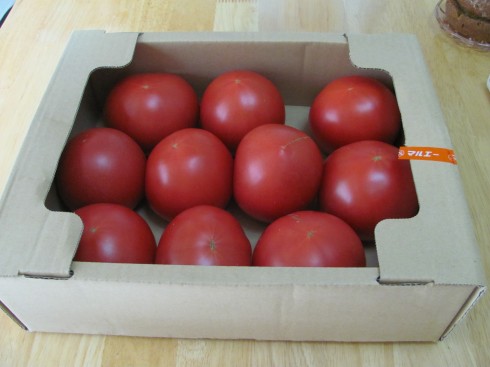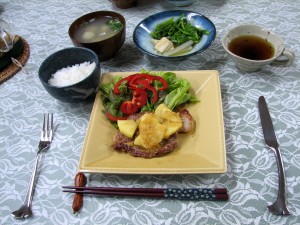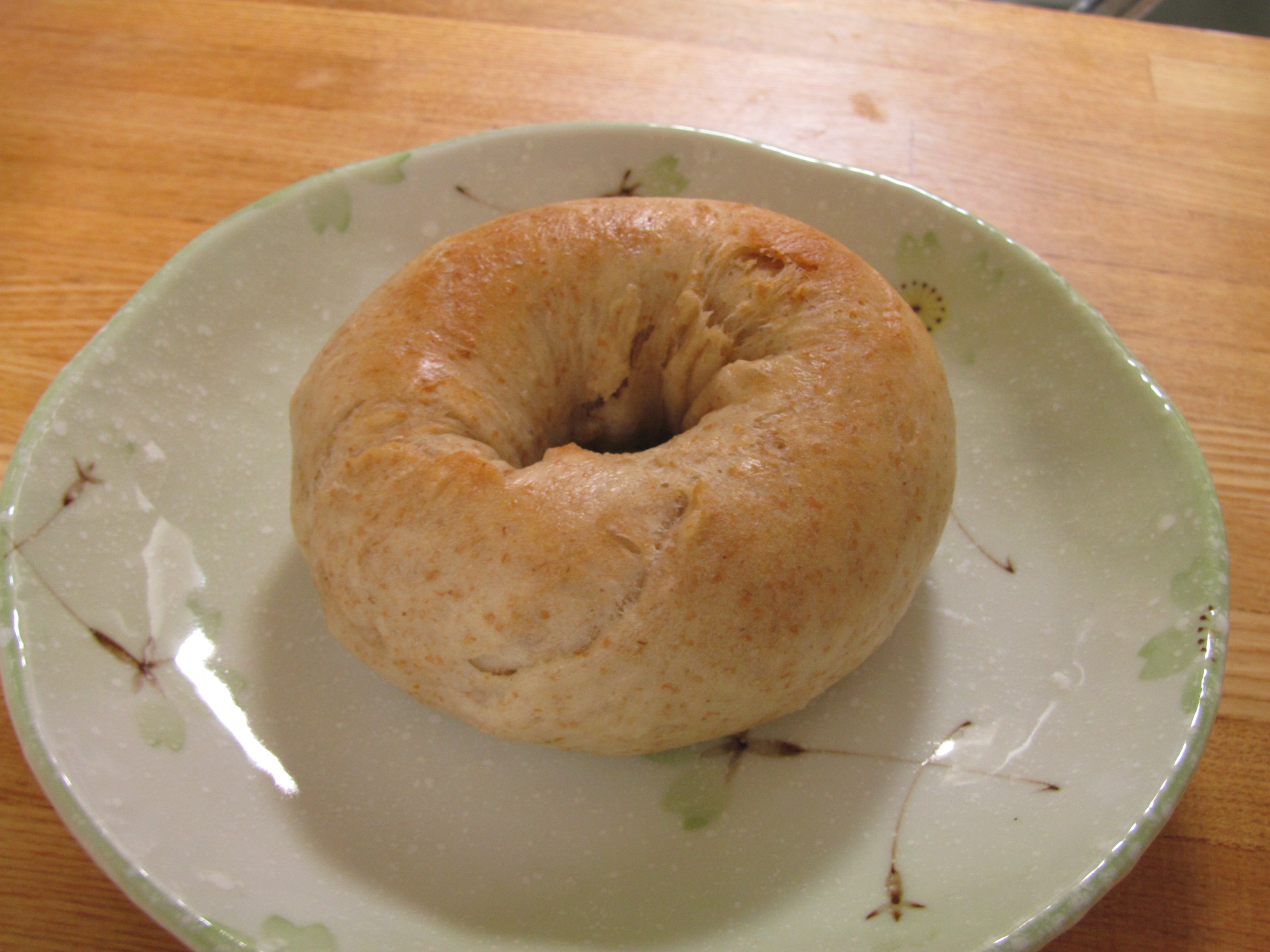How Miso is Made – A Visit to a Local Factory
Posted by Benjamin Martin, a 5th year JET on Kume Island in Okinawa, publisher of the blog MoreThingsJapanese.com and author of the YA fantasy series Samurai Awakening (Tuttle).
 Ever wonder what miso is? If you’ve been to Japan or eaten at a Japanese restaurant, you’ve likely had or at least seen miso. I remember my first time having miso soup. I was in college trying out a little Japanese restaurant that had popped up just outside the UofA. I was pretty green as far as Japanese food went so I ordered teriyaki chicken (I’m sure the chef was thinking all kinds of bad things about me). Before the meal, a bowl of soup appeared. It was a clear broth with some kind of brown particles floating in it. I tried the soup, but the flavor was so different from anything I had eaten before. I didn’t really enjoy it, but then it quickly grew on me. Now, I look forward to miso, be it in my soup, as a glaze for fish, or in the middle of a rice ball.
Ever wonder what miso is? If you’ve been to Japan or eaten at a Japanese restaurant, you’ve likely had or at least seen miso. I remember my first time having miso soup. I was in college trying out a little Japanese restaurant that had popped up just outside the UofA. I was pretty green as far as Japanese food went so I ordered teriyaki chicken (I’m sure the chef was thinking all kinds of bad things about me). Before the meal, a bowl of soup appeared. It was a clear broth with some kind of brown particles floating in it. I tried the soup, but the flavor was so different from anything I had eaten before. I didn’t really enjoy it, but then it quickly grew on me. Now, I look forward to miso, be it in my soup, as a glaze for fish, or in the middle of a rice ball.
I’ve studied Japan for a long time, and I’ve always translated miso as ‘fermented soy bean paste.’ Just like soy sauce, miso is made from soy, but it is only part of the story. A few weeks ago, my island had its sangyo matsuri where I was able to meet one of the people who make miso here (Kumejima‘s miso is quite popular). I was interested in the process so I wrangled a visit to the factory.
One of the first things I found out is that they don’t make miso all the time. Traditionally, miso was something made at home. Each family would make their own miso for their own use. As with so many things, the miso making skills are fading with the convenience of store-bought foods. Still, there are a few places that still do local miso. Since it is a fermented product, the temperature is an important factor, thus miso can only be made in moderate seasons. If it gets too cold, or too hot, the fermentation wont go on as well.
The process also takes more than three months. At the small local factories, they make large batches two or three times a year as needed. The rest of the time, they focus on other projects or on creating new items.
For more about how miso is made, including pictures, a walk-through of the process, and great miso based recipes, visit MoreThingsJapanese.com
Posted by Benjamin Martin, a 5th year JET in Okinawa, publisher of the blog MoreThingsJapanese.com and author of the YA fantasy novel Samurai Awakening (Tuttle).

Chahan is an Okinawan take on fried rice. Like many Okinawan dishes it is heavily influenced by Chinese cuisine. Like Chanpuru, a similar category of Okinawa cuisine, Chahan’s basic flavor comes from a combination of soy, garlic, and dashi. Since there are many ways to make or buy dashi, the final flavor of the dish, and the ease of its recipe can be changed depending on your approach. Modern Chahan also often has an American influence in the addition of spam. Below is a modern, yet quick take on this Okinawan dish. It is by far my most popular post on MoreThingsJapanese.com. I hope you enjoy my take on a classic Okinawan favorite.
Ingredients
- 3 servings cooked white rice
- 1 piman (green pepper)
- 1 tamanegi (onion)
- 1 package frozen vegetables
- 2 large eggs
- 170g meat (sausage, pork, chicken, spam, whatever)
- 2 tbsp extra virgin olive oil or no-stick cooking spray
Seasoning
- 1/4 tsp ginger
- 2 tsp hachimitsu (honey)
- 1 pkt dashi (5g)
- 1 tbsp powdered or minced garlic
- 4 tbsp soy sauce
- 1 tbsp sake (cooking, mirin, awamori, nihonshu, etc)
I’ll Make It Myself!: “Tomato Challenge: ALL the Tomato Recipes”
L.M. Zoller (CIR Ishikawa-ken, Anamizu, 2009-11) is the editor of The Ishikawa JET Kitchen: Cooking in Japan Without a Fight. A writer and web administrator for The Art of Japan: Kanazawa and Discover Kanazawa, ze also writes I’ll Make It Myself!, a blog about food culture in Japan, and curates The Rice Cooker Chronicles, a series of essays by JETs and JET alumni on the theme of cooking/eating and being alone in Japan.
New Rice Cooker Chronicles submissions always welcome. Just e-mail it to jetwit [at] jetwit.com.

I couldn’t resist buying a box of 10 large (230 g), gorgeous tomatoes for only 598 yen at the grocery store a few weeks ago. Tomatoes in Japan can be quite expensive, and although the price drops in the summer when they are in season, 600 yen might get you 5 if you are lucky.
How did I use my 10 tomatoes?
I’ll Make It Myself!: Whole-Wheat Pitas (Bread Revolution Series)
L.M. Zoller (CIR Ishikawa-ken, Anamizu, 2009-11) is the editor of The Ishikawa JET Kitchen: Cooking in Japan Without a Fight. A writer and web administrator for The Art of Japan: Kanazawa and Discover Kanazawa, ze also writes I’ll Make It Myself!, a blog about food culture in Japan, and curates The Rice Cooker Chronicles, a series of essays by JETs and JET alumni on the theme of cooking/eating and being alone in Japan.
New Rice Cooker Chronicles submissions always welcome. Just e-mail it to jetwit [at] jetwit.com.

More Bread Revolution and Guide to Flour.
“Pita pockets” didn’t excite me as a kid. Toted as a kid-friendly food, the charm of stuffing sandwich fillings into a bread with a pocket was lost on me. I rediscovered pita–fresh pita–in university at Middle-Eastern diners and as (store-bought) hummus became more mainstream. In Japan, I sometimes bought stacks of pita from the import store, but after preparing for an international cooking lesson, I discovered pita are really simple to make, and more importantly, make a great bread substitute for proper sandwiches in Japan. Save the trip to the import store for chickpeas–you don’t even need to make hummus to go with it!*
I’ll Make It Myself!: My Favorite Bamboo-Shoot (Takenoko) Recipes
L.M. Zoller (CIR Ishikawa-ken, Anamizu, 2009-11) is the editor of The Ishikawa JET Kitchen: Cooking in Japan Without a Fight. A writer and web administrator for The Art of Japan: Kanazawa and Discover Kanazawa, ze also writes I’ll Make It Myself!, a blog about food culture in Japan, and curates The Rice Cooker Chronicles, a series of essays by JETs and JET alumni on the theme of cooking/eating and being alone in Japan.
New Rice Cooker Chronicles submissions always welcome. Just e-mail it to jetwit [at] jetwit.com.

Early May means fresh bamboo shoots are in season again here in Ishikawa, and I received not one but three lovely shoots from my friends and coworkers this year! 2012 is apparently a bumper year for bamboo in the forests and in my kitchen.
Whether you purchased or received fresh bamboo, one large shoot can seem like a lot to cook up. The best English-language resource for cooking bamboo is, in my opinion, Makiko Itoh’s Just Hungry. The reason why I have only one bamboo recipe on this site is because I always use hers! What I do have to offer is how to cook raw bamboo, my master list of bamboo recipes, comments, and my own photos. Enjoy!
I’ll Make It Myself: Flour Tortillas (Bread Revolution Series)
L.M. Zoller (CIR Ishikawa-ken, Anamizu, 2009-11) is the editor of The Ishikawa JET Kitchen: Cooking in Japan Without a Fight. A writer and web administrator for The Art of Japan: Kanazawa and Discover Kanazawa, ze also writes I’ll Make It Myself!, a blog about food culture in Japan, and curates The Rice Cooker Chronicles, a series of essays by JETs and JET alumni on the theme of cooking/eating and being alone in Japan.
New Rice Cooker Chronicles submissions always welcome. Just e-mail it to jetwit [at] jetwit.com.
More Bread Revolution and Guide to Flour.

TexMex/Southwestern/Mexican foods were something I purchased from the grocery or at restaurants in the US, missed sorely in Japan, and was convinced I couldn’t make it myself. If I found salsa in a jar, I couldn’t find chips, so what was the point? Avocados weren’t something I could get my town easily, and forget cilantro or jalapeños. I gave up on my dream of enjoying these foods in Japan, but luckily Cheruko didn’t and put together a fantastic fajita spread for an international cooking lesson.
The Rice Cooker Chronicles — “Kaijo!” by Justin Maki
The Rice Cooker Chronicles is a series of essays by JETs and JET alumni on the theme of cooking/eating and being alone in Japan. The brain-child of JETwit founder Steven Horowitz (Aichi-ken, Kariya-shi, 1992-94) (and inspired by the book Alone in the Kitchen with an Eggplant), this series is curated by L.M. Zoller (CIR Ishikawa-ken, Anamizu, 2009-11), the editor of The Ishikawa JET Kitchen: Cooking in Japan Without a Fight. A writer and web administrator for The Art of Japan: Kanazawa and Discover Kanazawa, ze also writes I’ll Make It Myself!, a blog about food culture in Japan.
New submissions always welcome. Just e-mail it to jetwit [at] jetwit.com.
******
Kaijō!
by Justin Maki (ALT Osaka-fu, 2002-06), a writer and editor currently working at the Sports desk of Kyodo News America in New York City. Justin’s short fiction, poetry, and essays have appeared in a handful of small journals. Contact him at makij408@gmail.com.
“When you go to the kitchen to prepare dinner, be born in the kitchen. When you finish there, die. Then be born at the dining table as you eat your dinner and, when you finish eating, die there. Be born in the garden, and sweep with your broom. When you get into bed at night, die there. And when daylight comes, and you awaken in your bed, be born anew.”
I’ll Make It Myself– ベーガル革命: Whole-Wheat Bagels
L.M. Zoller (CIR Ishikawa-ken, Anamizu, 2009-11) is the editor of The Ishikawa JET Kitchen: Cooking in Japan Without a Fight. A writer and translator for The Art of Japan: Kanazawa and Discover Kanazawa, ze also writes I’ll Make It Myself!, a blog about food culture in Japan.
もちもち (mochimochi): springy (texture)
Back in my language-school days at Midd, a New-Yorker foodie friend got on my case for eating the dining-hall bagels, telling me, “That’s not a bagel. That’s a piece of bread shaped like a bagel.” It’s probably for the best that he doesn’t find out what sort of things pass for “bagels” in Japan–it’s more like “cake shaped like a bagel.” Sometimes you can get passable bagels in the chain bakeries of Kanazawa, and Kaldi Coffee sometimes has imported frozen bagels, but they’re a bit pricey. Either way, it’s not just like popping over to Espresso Royale for a fresh Barry’s Bagel during an intense paper-writing session.
Bagels are one of those foods that seem very intimidating in part because of the multi-step process of making them: using yeast, letting the dough rise, shaping, boiling, and then finally baking; and in part because you really never need to make them in the US when they’re so widely available.
CLICK HERE to read the full post.



